Water Acquisition in Survival & Emergencies Scenarios
After shelter from harsh climates, water is the most vital resource required by human beings. Survival experts will continually impress on students that you can only go a few days without water and possibly even less under extreme conditions, exertion or while enduring injury or illness. The following article is a high level overview of various techniques for a wide variety of climates and terrain. Obviously, only a few may apply to your situation, but since you never know when you’ll find yourself in a demanding environment, familiarity with methods outside your normal area are always a good idea.
Where NOT to Get Water
As a rule, the following are never a good source of water. They are either extremely hazardous of counter-productive to maintaining hydration. Do not fall prey to hydration myths and Hollywood survival techniques.
- Urine.
- Fish juices.
- Blood.
- Sea water.
- Alcohol.
- Melted water from new sea ice.
Identifying Potential Water Sources
Your first step is to identify locations or materials you may be able to acquire water from. In order of acquisition, these are generally:
- Surface water (streams, lakes, and springs).
- Precipitation (rain, snow, dew, sleet)
- Subsurface (wells, cisterns, caves).
- Ground water (when no surface water is available)
- Vegetation
Once you have identified a potential water source, your next steps are collecting it, assessing its purity/safety and treating it, if necessary.
Surface water may not be immediately visible, especially in rugged or obscured terrain. Abundance of lush green vegetation, particularly if surrounded by less-lush or arid areas. Look for drainage areas, downhill trends in the terrain and low ground. Animals can be an excellent indicator for the presence of water: “V” intersecting game trails, swarming insects, bird flights in the early morning or late afternoon, all might indicate a water source nearby. Even if the result of your search is a dry stream or pond bed, do not give up. Such areas may contain pockets of water under overhangs of vegetatation and rocks. Explore thoroughly. Failing surface water, such areas may be candidates for the extraction of subsurface ground water.
 |
Snow and Ice are potentially a mixed blessing. While they represent a potentially clean source of water, their direct consumption can lead to hyperthermia. Snow and ice should be melted with fire if available. If not, melt small amounts in a water tight container between layers of worn clothing (NOT directly against the skin). Even muddy/dirty snow and ice can be a valuable water source and filtered through a piece of fabric. Ice near the sea or on the open ocean has some special rules. As ice ages in cold oceanic enviroments it becomes less and less salty until it is known as old sea ice. Old sea ice is bluish or blackish, while newer ice is milky or gray.
Subsurface or Ground Water
These source of water can require significant exertion and processing to acquire but if they are your only options, be certain you can begin work safely, have sufficient energy and will be in the area long enough to benefit from your efforts.
On islands and coastal regions, a beach well is one way to acquire fresh(er) water than the nearby salt water. While this water may not be completely salt free, it can be sufficiently low enough in salt content to hydrate the body. Such water can be further purified to lower salt content by using a solar still (in a warm environment) or freezing (if you are in a cold climate).
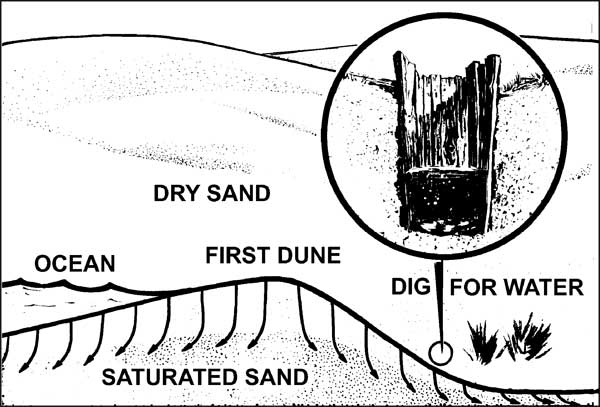 |
Swamps and marshes, by definition, have enormous amounts of water, but this water is extremely contaminated by debris and organisms. Using a technique called a seep well, you can eliminate a large amount of this dangerous contamination. Water collected in this method should still be filtered and purified before consumption to further guarantee its potability.
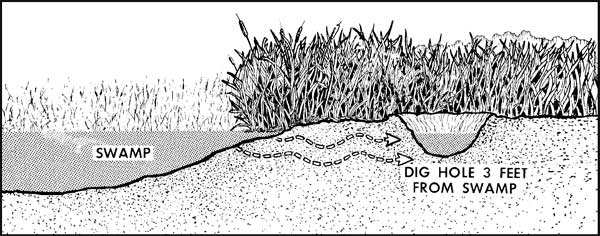 |
Water From Vegetation
Plants draw and store water with great efficiency. In enviroments with any living plants it may be possible to extract life-saving amounts of water. Depending on the vegetation in your area and its abundance this can be a practical alternative to other means of water acquisition. The solar still and transpiration methods mentioned below are safe for almost any form of plant and require little or no further treatment.
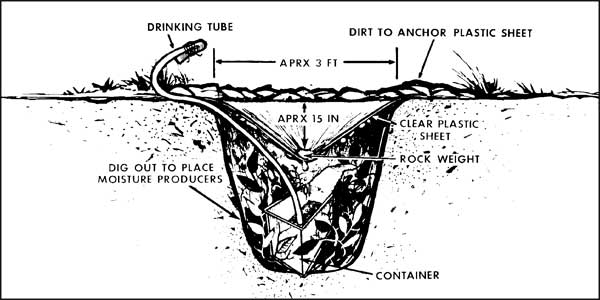 |
 |
For methods of directly extrating water from plants, it is vital to test the plant in question before considering it as a candidate for direct extraction. Plants with milky juices should be avoided. Test various plants and select those with the clearest liquid that possess the least odor or taste. Unless you are highly skilled in identifying safe water plants, also sample small amounts of these liquids before consuming larger amounts.
 |
When cutting plants for water as shown above, avoid touching the plant with your mouth or lips. Many plants have irritating or contaminated surfaces. When water flow stops, cut off 6 inches of opposite end, water will flow again. If you are harvesting water from slow seeping plants, remember that most plans seep more water at night.
While the liquid contained in green coconuts is a famous source of water, use them sparingly as ripe coconuts may cause serious diarrhea, defeating your attempts to hydrate.
Water Purification
Remove large contaminates by filtering through cloth. Even a hankerchief can remove solid materials and larger contaminants. This process can be enhanced further by using sand or fine charcoal (from your fire). Unless you have access to purification chemicals or a specialized water filter, you’re most common method of neutralizing micro-organisms will probably be fire. One minute of boiling should suffice for survival situation.
Without fire, the UV radiation of strong sunlight can greatly reduce the number of micro-organism in water. Water purified in this method should be sealed in a clear ccntainer and exposed to the strongest sunlight possibly for at least three hours (five is better).
Finally, “aerating” water by vigorously pouring it from one container to another can improve the taste and also introduce oxygen which is detrimental to many micro-organisms.
Additional Research:
  |
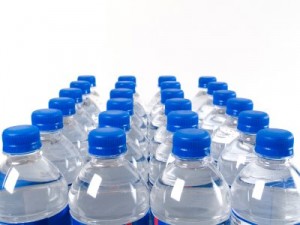
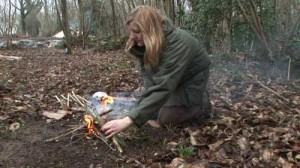

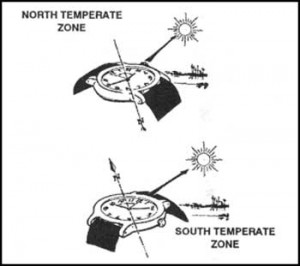

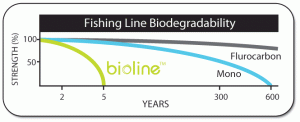
Leave a Reply